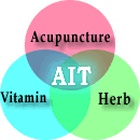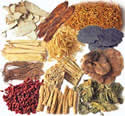|
|
|
 |
|
 |
||||
|
|
|
Traditional
Chinese Medicine (
TCM )
Regulation of Yin and Yang: The occurrence of any diseases is, fundamentally speaking, due to the relative imbalance of yin and yang. In other words, the normal inter - consuming - supporting relationship between them is disturbed by either a preponderance or a discomfiture of yin and yang. Regulation of yin and yang is therefore a fundamental principle in clinical treatment. How to regulate yin and yang is most important in TCM treatment , such as acupuncture. Yang
in excess makes yin suffer and yin in excess makes yang suffer. Excessive
heat ( yang ) is likely to injure ( yin ) essence, while excessive cold
( yin ) is likely to damage yang energy ( Qi ). TCM reduces excessive
heat or expels cold through the methods of " removing the excess
" and " reducing the preponderance. " To regulate the
preponderance of yin or yang, attention should be paid to the patient's
condition, whether a corresponding yin or yang deficiency exists. For
example if Yin is deficient, consideration should be given to both yang
reduction and yin reinforcement, dispelling cold and cooling yang simultaneously. Yin and yang are considered the general principles for differentiation of syndromes, relieving deficiency by the tonifying method, reducing excess, dispelling cold by the warming method, nutrient and defensive Qi regulation, and Qi and blood promotion, all fall into the aspect of regulation of yin and yang. Acupuncture therapy is to apply different techniques of manipulations to meridian points on the body, thus treating diseases by means of regulating yin and yang. Strengthening the Body Resistance and Eliminating the Pathogenic Factors: The course of a disease is actually the process of a struggle between the antipathogenic factors and pathogenic factors. Mobilizing the antipathogenic factors to defeat the pathogenic factors is the right way to cure the disease. Therefore, strengthening the body resistance and eliminating the pathogenic factors are also important principles in clinical treatment. To strengthen the body resistance is to reinforce the antipathogenic Qi ( energy )and build up health. Once the body resistance against disease is strengthened, the pathogenic factors are eliminated. Once the pathogenic factors are removed, the body resistance will be reinforced. Since they are closely related to each other, strengthening the body resistance is beneficial to dispelling the pathogenic factors and vice versa. Clinically, the condition of the pathogenic factors and antipathogenic factors should be carefully observed, upon which it can be determined whether to strengthen the body's resistance first or to expel the pathogenic factors first. For patients with weak body resistance whose pathogenic factors are not yet strong enough, the body resistance is strengthened first. For patients with excessive pathogenic factors whose body resistance is not yet damaged, the prime task is to eliminate the pathogenic factors. But for patients with both weak body resistance and excessive pathogenic factors, both methods should be employed simultaneously. We try to distinguish what is primary from what is secondary. Those patient with weak body resistance priority should be placed on a body resistance building program which also does something to get rid of the pathogenic factors, and vice versa. When the patient is in a relatively critical condition, attacked by excessive pathogenic factors, and the body resistance is too weak, strengthen the body resistance first and then remove the pathogenic factors. If the patient is in a very poor condition with excessive pathogenic factors, but with weak body resistance, eliminate the pathogenic factors first and then strengthen the body resistance. Distinguishing the Primary from the Secondary: The conception of the primary and the secondary are relative to each other. In terms of the antipathogenic factors and pathogenic factors, the former is the primary, and the latter is the secondary. Judged by the etiology and manifestation, the etiology is the primary, and the manifestation is the secondary. As to the localization of a lesion, the internal portion is the primary, and the external is the secondary. As for the clinical course of a disease the original is the primary, while the complication is the secondary. This concept represents the two opposite aspects of one entity during the course of a disease. The symptom is generally the phenomenon and the secondary aspect, the root cause is generally the nature and the primary aspect. Clinically, a disease should be assessed according to such different conditions of the primary, the secondary, the root cause, the symptoms, the acute, and the chronic so as to ascertain the main aspect of the contradictions, and thus to treat accordingly. Under general circumstances, the primary or root cause should be found first, but if the symptoms are acute, they should be treated first. If the symptoms and root cause are both serious, they should be taken into account at the same time. Trying to find out the primary or root cause is of great importance. In the clinic, the nature and the primary aspect of a disease should be well understood in order to treat the root cause. For some diseases, although their symptoms are different, the etiology and pathogenesis are the same, so they can be treated by the same method. For example, in the case of a sore throat due to yin deficiency of the kidney and low back pain due to yin deficiency of the kidney, the treatment to nourish the kidney yin is adopted. This is called " treating different diseases with the same method. " For some other diseases, although their symptoms are alike, the etiology and pathogenesis are different, so different methods should be used to treat the root cause. For instance, a headache due to liver yang hyperactivity should be treated by nourishing yin to reduce yang. but a headache caused by both qi and blood deficiency should be treated by reinforcing qi and blood. However headache caused by invasion of the meridians by wind cold must be treated by diminishing wind cold. This is called " treating the same disease with different methods. " Under certain circumstances, the symptoms are very critical. If not treated immediately, they shall affect the treatment of the root cause or perhaps cause death. In this case it is necessary to observe the principle of " treating the symptoms First when they are acute, and treating the root cause when these symptoms are relieved. " For example, if a patient with chronic cough and asthma caught a common cold, accompanied with fever and aversion to cold, the common cold should be treated first because it is the acute aspect. After the common cold is relieved, treat the chronic cough and asthma which are the primary aspect. But if the primary and secondary aspects are both serious, they must be treated at the same time. Prevention: Prevention
is also an important aspect in treating the primary aspect. It includes
prevention before the attack of a disease and prevention from deterioration
after occurrence of a disease. China has a long and rich experience
in health care, such as Qigong, Taiji, Baduanjin, etc. Acupuncture and
moxibustion are also traditional remedies to prevent disease. Zusanii
( S 36 ) , for example, located on the lower part of the leg , is an
important tonifying point. Moxibustion at the point is not only good
for preserving health, but also good for preventing many kinds of diseases.
Importance is attached to early diagnosis and treatment of disease for
fear of its negative development. During the prevention and treatment
of diseases, doctors are requested to know the laws of their occurrence
and development and the ways of their transmission. It is recorded in
the " Treatise On Febrile Disease": " If the illness
is going to invade other meridians, needle Foot - Yangming Meridian
to stop the development. " The importance of preventing diseases
from transmission is clearly stated here.
|
| Note: The information provided on this website is for informational purposes only and is not intended to be used as medical instruction, it can not be as a substitute for advice from your physician. The appropriate health care professionals should be consulted before taking any action. |
|
|